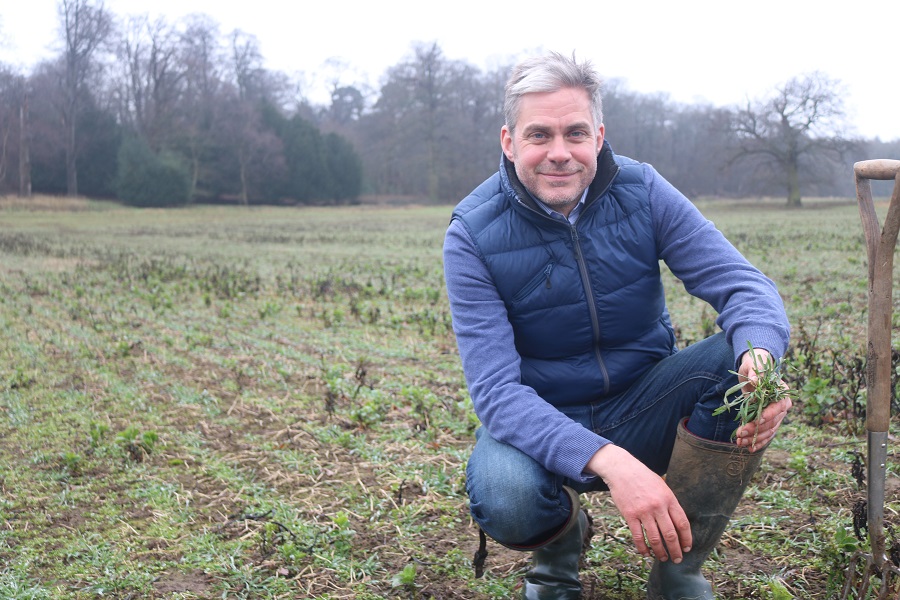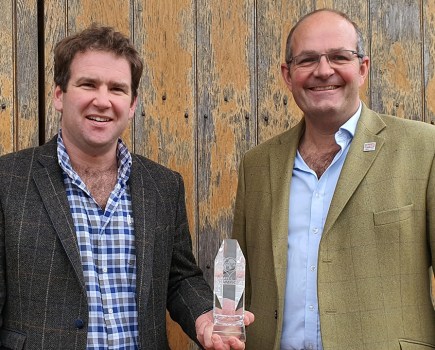With productive soils that capture carbon, the Southill Estate in Beds has turned its focus to reducing N inputs. CPM visits to gauge the driving force behind the changes.
We’re already carbon negative on land on which we’re also growing food.
By Tom Allen-Stevens
There are two aspects that stand out about Mike Purnell’s rye crop as you step into it: the first is that the crop rows are interspersed with clover. The second is that there’s not a puddle to be seen, after a night of heavy rain in mid Jan. Littered with wormcasts, the ground feels strangely firm underfoot for the time of year.
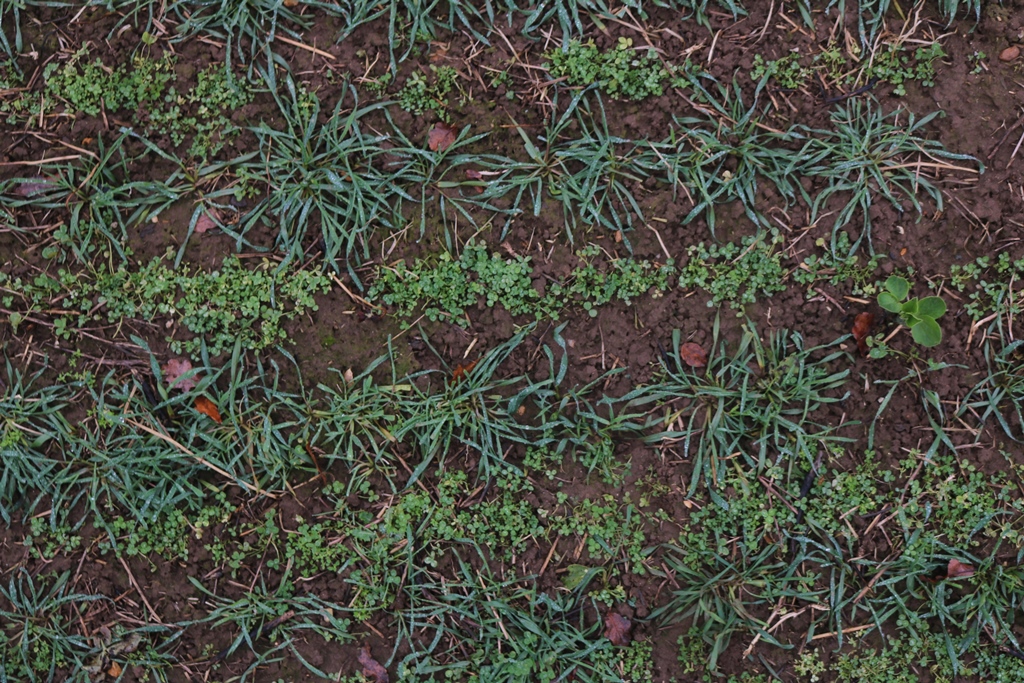
The idea with the clover is that it remains as a permanent crop, providing N for the cash crop, and also helps suppress weeds.
“What we’ve focused on is soil health,” Mike explains. “We don’t cultivate, have plenty of different crops in the rotation and aim to keep living roots in the soil for as much of the year as possible. The result is that we’re already carbon negative on land on which we’re also growing food.”
His enthusiasm is for a regenerative agriculture system that’s been carefully shaped over 17 years. Ever since Charles Whitbread became the custodian of the 4500ha Southill Estate, near Biggleswade in Beds, he’s led a revolution that has seen Whitbread Farms and the enterprises the business fosters pursue a decidedly sustainable path on the in-hand 1500ha farm.
The building blocks were firstly to open up the rotation from oilseed rape and winter wheat that were causing a grassweed headache. Straw was incorporated and then cover and catch crops introduced. Cultivations had been gradually wound down by Charles’ father until the whole estate went no-till in 2016. These steps have gone hand-in-hand with a drive for biodiversity, both with cropping and wildlife habitats above ground and in encouraging life in the estate’s soils. Regular tests of drain and ditch water quality are among checks to ensure the plan’s on track.
A close eye has also been kept on soil organic matter, which has risen on average by 1% over the last five years, across soils that vary from gravel, through greensand to heavy Denchworth clay. This steady rise is the main reason there’s now a healthy measure of carbon sequestered every year to offset the emissions across the 1000ha of arable cropping. An analysis of the winter wheat enterprise using the Cool Farm Tool has shown the carbon footprint has reversed from 430 kg CO₂e per tonne emitted in 2014 to 64 kg captured in 2019.
“To be truly sustainable it’s important the arable operation stands alone as carbon neutral, with no offsetting elsewhere on the estate,” notes Mike. “It would be a lot easier to calculate our footprint if all inputs arrived at the farm gate carbon neutral, with the farm just responsible for the emissions from storage, application and utilisation. I ask for the inherited footprint of all the inputs we buy, although few can give me a response.”
A quick turnaround of crops, direct drilled after harvest, lie behind the estate’s low carbon arable system. “Within 48 hours of the combine leaving the field we’ve drilled the catch or cover crop. We’ve three drills, which may sound excessive, but that’s all the cultivation kit we have and means we can match whatever conditions our wide range soils present.
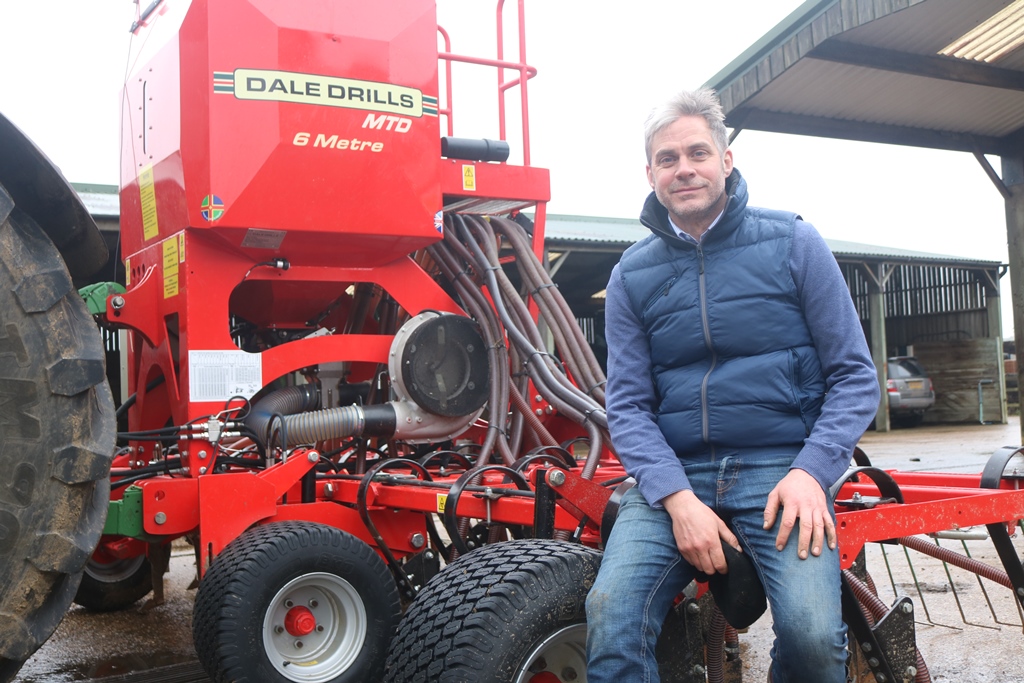
The Dale MTD drill is one of three on the farm that ensure the right no-till drill is used on the right day, says Mike Purnell.
“The 6m John Deere 750A is brilliant at establishing into a big cover but can tend to hairpin straw and leave open slots when it’s wet. We’ve an 8m Horsch CO drill with Metcalfe points that delivers cost effective drilling at high output and is the drill of choice for the autumn. But these last couple of years the packer roller has bunged up when conditions turned tricky. That’s where a new 6m Dale MTD comes in – we just use the right drill on the right day,” he explains.
With the estate already in good shape when Mike arrived in 2018, he set about addressing one of its biggest carbon, as well as financial, costs – fertiliser. “We’d already tackled fuel use with the move to no-till. This and the cover cropping mean the soil is in good health – it feels and smells right. That’s a sound basis for reducing the N input – 60% of our carbon footprint is synthetic fertiliser yet for every 100kg you apply the industry accepts that only about 50-60kg is used by the crops.”
That’s the driver behind the white clover into which the rye has been drilled. “We’re trying to grow our own N. The idea with the clover is that it remains as a permanent crop, and also helps suppress weeds. Before drilling a cash crop, you can knock it back with glyphosate – that doesn’t kill the clover but the shock results in nitrogen release to the seedbed. The difficulty with the system is knowing how you can reduce N applications.”
Mike’s already made an impressive start, even before this new practice is taken into account. He applies just 200kgN/ha for a 9t/ha milling wheat crop, while historically it would have needed 280kgN/ha. He’s been working with Neil Fuller of Atlas Biosystems, who’s helped the estate transform its soils over the past 20 years and make the most of the living mulches.
“There’s no doubt the leguminous cover crops and especially the companion clovers put N as well as life into the soil – red clover captures about twice as much as white clover and can release up to 160kgN/ha over 18 months. But the way this is released is very unpredictable,” Neil explains.
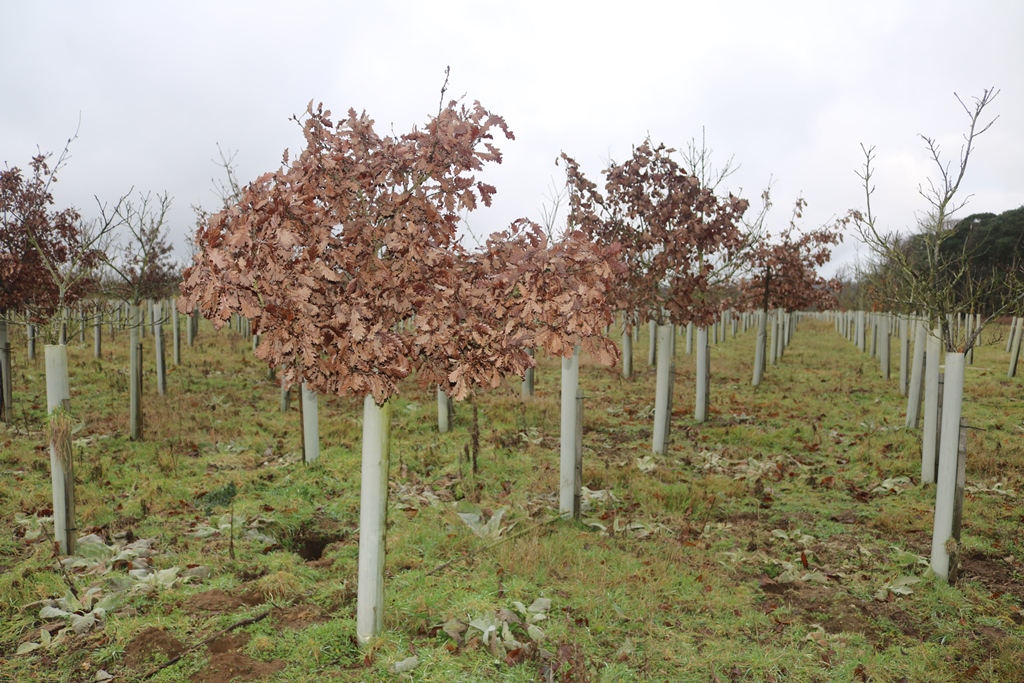
Trees are replaced with deciduous hardwood, while 200ha of land in environmental stewardship offer offsetting opportunities.
While chicken muck and biosolids add to the organic-N mix, applications of synthetic fertiliser are applied as liquid through the farm’s Agrifac 36m sprayer with 5000-litre tank with individual nozzle control to reduce overlaps. Nitrification inhibitors are used with all applications to reduce emissions and improve nitrogen use efficiency (NUE) – Liqui-safe, which combines nitrification with urease inhibitor, is being tried this year. Molasses are also added, believed to act as a chelating agent, while the C in the sugars feeds the microbes that help convert the urea into available N, improving the N-use efficiency. “Since using molasses, we haven’t seen any scorch,” adds Mike.
This year, however, he’s conducting a trial in which no synthetic N at all will be applied to the soil. “We’re going to rely on foliar-applied N to give the crop what it needs on top of the chicken muck and living mulches. It’s more efficient than soil-applied N, although the limitation is how much the leaf can absorb, so we may have to make 3-4 applications.” Other trials this year involve Tiros seed dressing to try to utilise atmospheric N in place of synthetic.
Another practice, still at the trial stage, is intercropping with peas. Here Mike’s working with Steve Baker from Agrii to select varieties that will complement each other through the spring and summer. Last year, a 20ha field of KWS Siskin was drilled in Oct and 4ha of this had Mankato peas stitched in between the rows in April.
“The crop got off to an exceptional start but unfortunately fizzled out in the dry spring. It’s a system with great potential, however, although we’ve a lot to learn about how much N the peas feed to the wheat,” notes Steve.
Undeterred, Mike’s mid-Oct drilled KWS Zyatt will get an intercrop of peas this April. “Although the peas failed last year, the yield of Siskin was no worse where they’d been sown than in the rest of the crop, and the peas didn’t suffer any pigeon damage as the wheat disguised them,” he notes.
Once the peas are drilled, the aim is that no further applications of any kind are made to the crop. That puts a slant on variety choice, but it’s one that Mike aims to follow in every crop with every variety. “The AHDB Recommended List is all very well, but it puts varieties through a fungicide and fertiliser regime that isn’t relevant to what I’m doing.”
So instead, he’s guided by Agrii’s Advisory Lists, as Steve explains. “This is information we’ve compiled from our extensive in-house trials programme that gives varieties a sustainability score, which sits alongside the AHDB ratings. It gives you a true picture of disease resistance, and additional measures such as ability to compete against blackgrass and early season vigour. For growers like Mike, the information is essential to inform how varieties will perform in a regenerative agriculture system.”
Mike takes a similar approach to the markets he chooses for the crops he grows. “We’ve made a conscious decision as a farming business that we want to grow food for quality markets, so we’re not growing barn-filling wheats as a feed source for livestock systems that may be less sustainable. We’re actively looking for low-carbon markets – there aren’t many opportunities for a single farm acting alone, but I hope we can join with other farms making progress in this area,” he notes.
Steve adds that bringing growers together to supply a market opportunity is an area where Agrii has experience. “The Explorer spring barley contract we have is in its seventh year. This gives growers a premium for high-N barley supplying Budweiser.”
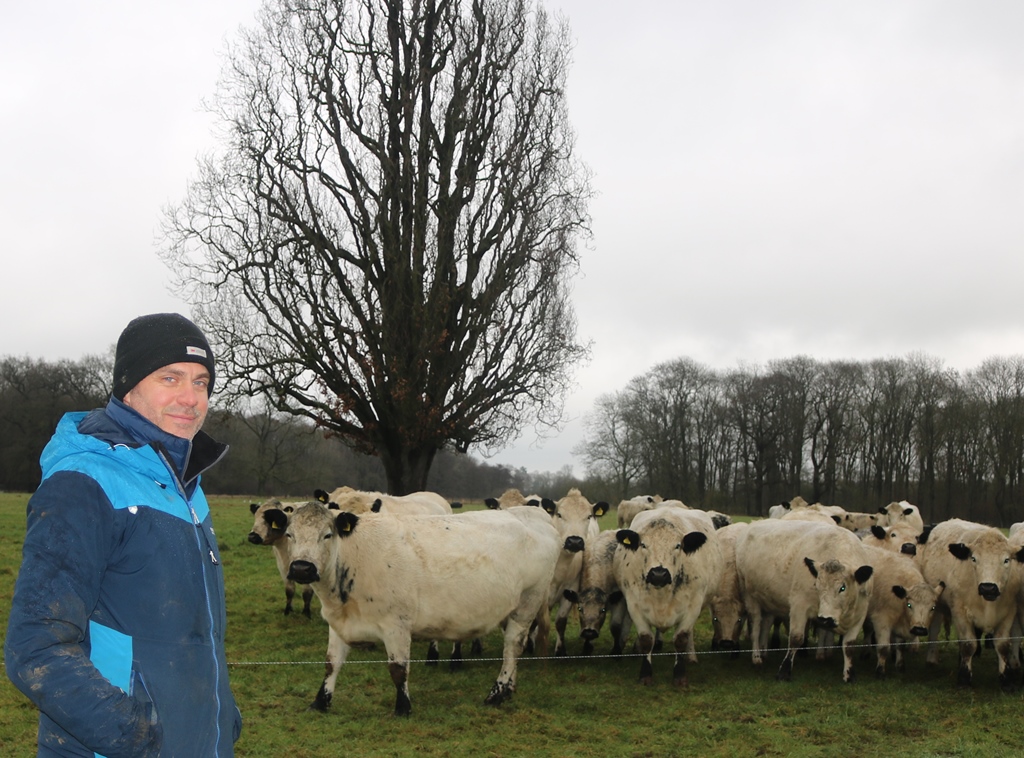
The herd of British White cattle are mob-grazed, given fresh pasture and moved daily.
The approach to sustainability follows through into other farm enterprises, too – there’s 100ha of permanent grassland supporting a small beef suckler herd of British White cattle. These are mob-grazed, given 0.5ha of fresh pasture every day and moved daily, Mike explains. “This encourages the roots to grow to depth on our relatively light grassland soils. The result is better drought tolerance of the pasture and carbon captured in the soil, making it a very sustainable way to produce beef. The cattle emissions are reduced because they’re eating what they have evolved to eat – no hard grains or concentrate is fed”
There’s around 200ha of the estate in higher-level or mid-tier stewardship, and here the emphasis is on biodiversity, nature conservation and improvement – a policy that’s followed in the woodland, too.
“Although originally planted with mainly Scots pine, that’s being replaced with native deciduous hardwoods as areas are felled and replanted. We’ve also suffered a lot of ash die-back,” he notes. The timber is processed through a biomass boiler which heats the main house and estate offices. Three separate solar sites on shed roofs and one field-based site supply 1.2M kWh of green energy for the estate as well as exporting to the grid.
It’s clear Mike’s enthusiasm lies in the arable enterprise and in exploring more how regenerative agriculture can further improve the soils. “We’re looking into how we can get carbon accreditation so we can trade the carbon we sequester. As with other markets, I feel the opportunity lies in like-minded farmers coming together, pooling ideas and providing a combined resource, not only to get arable farming towards its Net Zero target, but deliver this for the nation, too.”
What makes Mike Purnell a Climate Change Champion?
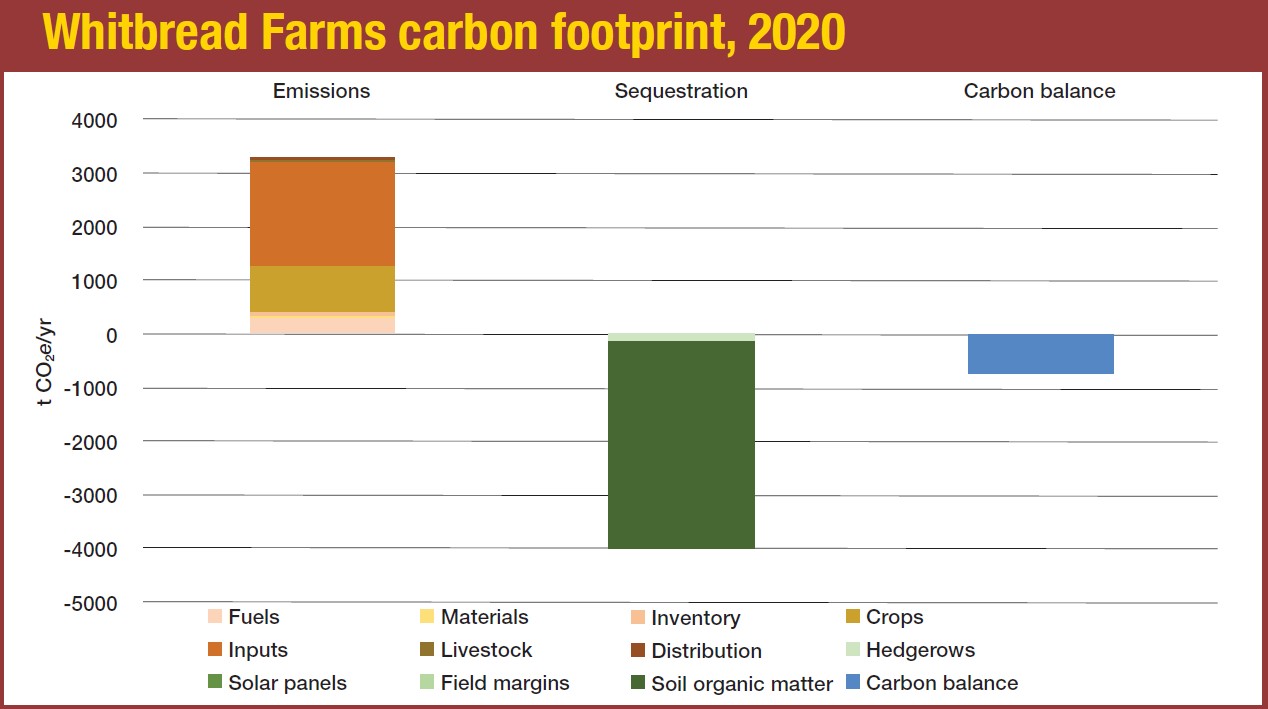
Source: Whitbread Farms, June 2020, calculated using Farm Carbon Calculator. Figures shown are indicative.
Innovative ideas
Practices such as companion cropping, intercropping, and drilling into a white clover understorey demonstrate that Mike is keen to try new ideas to improve the sustainability of the Southill Estate’s arable enterprise. The strategy is followed through to every aspect of the farm with a conviction that would inspire others.
Productivity push
Yields have been maintained while synthetic nitrogen inputs have significantly reduced through the novel approaches that continually evolve. A focus on quality markets, with opportunities sought for low carbon produce, underpin a truly sustainable food offering.
Cultivation care
Soil health lies at the heart of the move to zero tillage and has resulted in a steady improvement in soil organic matter, responsible for the majority of the estate’s carbon sequestration. Mike’s set a course to continue this impressive progress.
Bio-based boldness
The way the estate’s environmental assets are managed not only bring improvements in its biodiversity but have given rise to offsetting opportunities.
Joined-up action for food and farming sustainability
Climate change is a challenge the best of British food and farming is well-placed to address, believes Agrii head of technical, Clare Bend. It sits alongside the loss of the Basic Payment and introduction of Environmental Land Management, growing legislative and environmental pressures and a diminishing crop protection armoury.
However, she insists it can only do these together by applying the best scientific intelligence and practical experience in a thoroughly joined-up way; a way which makes the most of the synergies among different economic, environmental and social sustainability aims while balancing what can be seriously competing pressures between them.
“The one thing that seems to be stacking up faster than the challenges farming faces these days is the often-impractical advice we’re getting from all sides on what needs to be done,” she stressed at this month’s launch of Agrii’s industry-wide sustainability improvement initiative.
“Green Horizons is our recipe for replacing the clamour of conflicting sustainability messages with well-researched, planned and focussed action. Through its package of practical measures, we intend to make sustainability really work for British food and farming.
“It’s all about actions rather than words from everyone in our business; progressive across-the-board improvement based on sound science; and harnessing the sort of forward-thinking so evident at businesses like Whitbread Farms to develop better practice for consistent gains.”
These businesses will form part of the thought-leading Green Horizons farmer network being developed as part of the initiative which also includes an annual innovation awards scheme; fast-track bio-solutions screening programme; advanced soil health assessment regime; Net Zero Carbon iFarms; reduced input R&D challenge projects; accredited environmental training and extended enterprise benchmarking.
“Underpinning everything we do moving forward, our initiative is also geared to making the voice of practical farming sustainability heard, understood and increasingly appreciated beyond the industry,” Clare added. “We are already working closely with a broad range of food industry, environmental and other partners to bring this about, and look forward to extending this engagement to all those who share our ambition for a truly sustainable countryside – economically, environmentally and socially.”
Climate Change Champions
UK Farming has set itself the challenging target of Net Zero emissions by 2040. Although led by the NFU, it will take the entire industry, working together in a partnership approach to meet this ambitious goal.
But there are individual growers, thought leaders who have already started on this journey. They have the ideas, the progressive outlook and the determination to shape positive change. CPM has teamed up with leading agricultural suppliers who have a credible Net Zero aspiration to identify these individuals and bring them into the top-level discussion about how farming can position itself as the solution to climate change.
CPM would like to thank our sponsors: Agrii, BASF, BKT, CF Fertilisers, KWS, Interagro, Lloyds Bank, Small Robot Company

